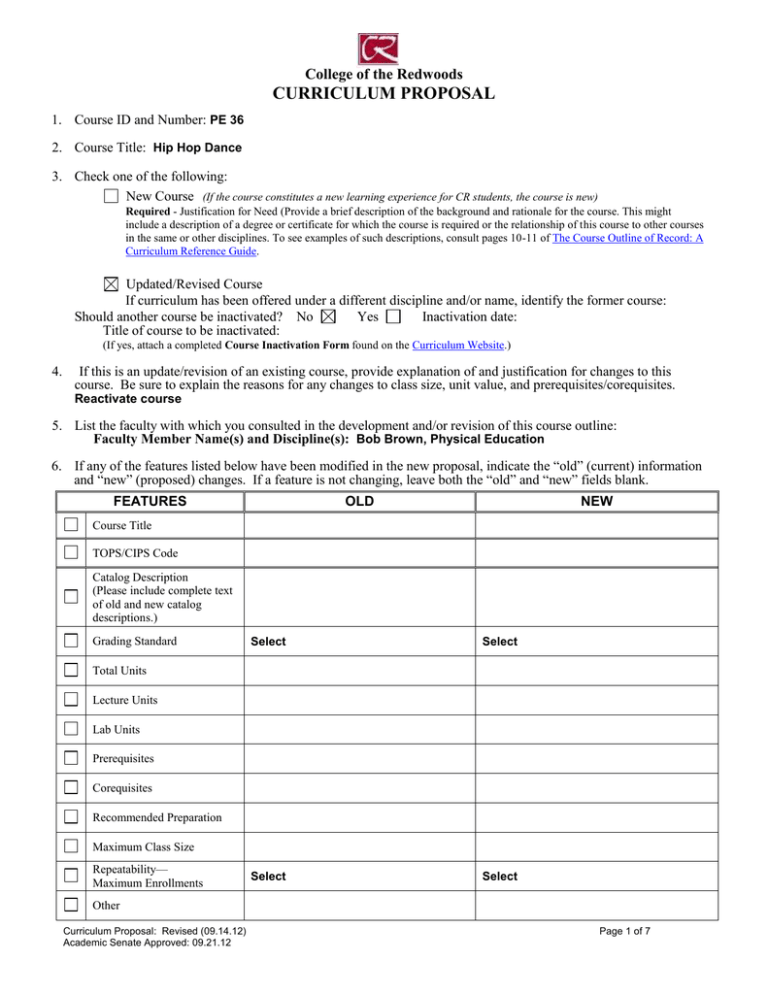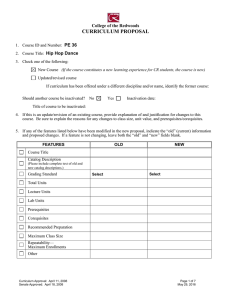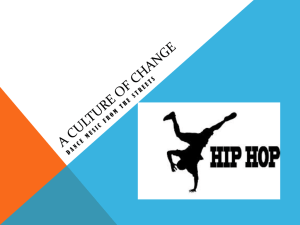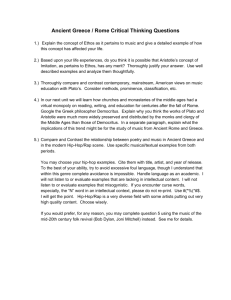CURRICULUM PROPOSAL College of the Redwoods 1. Course ID and Number:
advertisement

College of the Redwoods CURRICULUM PROPOSAL 1. Course ID and Number: PE 36 2. Course Title: Hip Hop Dance 3. Check one of the following: New Course (If the course constitutes a new learning experience for CR students, the course is new) Required - Justification for Need (Provide a brief description of the background and rationale for the course. This might include a description of a degree or certificate for which the course is required or the relationship of this course to other courses in the same or other disciplines. To see examples of such descriptions, consult pages 10-11 of The Course Outline of Record: A Curriculum Reference Guide. Updated/Revised Course If curriculum has been offered under a different discipline and/or name, identify the former course: Should another course be inactivated? No Yes Inactivation date: Title of course to be inactivated: (If yes, attach a completed Course Inactivation Form found on the Curriculum Website.) 4. If this is an update/revision of an existing course, provide explanation of and justification for changes to this course. Be sure to explain the reasons for any changes to class size, unit value, and prerequisites/corequisites. Reactivate course 5. List the faculty with which you consulted in the development and/or revision of this course outline: Faculty Member Name(s) and Discipline(s): Bob Brown, Physical Education 6. If any of the features listed below have been modified in the new proposal, indicate the “old” (current) information and “new” (proposed) changes. If a feature is not changing, leave both the “old” and “new” fields blank. FEATURES OLD NEW Course Title TOPS/CIPS Code Catalog Description (Please include complete text of old and new catalog descriptions.) Grading Standard Select Select Select Select Total Units Lecture Units Lab Units Prerequisites Corequisites Recommended Preparation Maximum Class Size Repeatability— Maximum Enrollments Other Curriculum Proposal: Revised (09.14.12) Academic Senate Approved: 09.21.12 Page 1 of 7 1. DATE: 11/8/12 2. DIVISION: Physical Education 3. COURSE ID AND NUMBER: PE 36 4. COURSE TITLE: Hip Hop Dance (Course title appears in Catalog and schedule of classes.) 5. SHORT TITLE: Hip Hop Dance (Short title appears on student transcripts and is limited to 30 characters, including spaces.) 6. LOCAL ID (TOPS): 0835.10 Taxonomy of Program Codes 7. NATIONAL ID (CIP): 310501 Classification of Instructional Program Codes 8. DISCIPLINE(S): Athletic Training, Physical Education, Dance Select from Minimum Qualifications for Faculty Course may fit more than one discipline; identify all that apply: 9. FIRST TERM NEW OR REVISED COURSE MAY BE OFFERED: Fall 2013 10. COURSE UNITS: TOTAL UNITS: 0.5-1.0 LECTURE UNITS: TOTAL HOURS: 27-54 LECTURE HOURS: (1 Unit Lecture = 18 Hours; 1 Unit Lab = 54 Hours) LAB UNITS: LAB HOURS: 0.5-1.0 27-54 11. MAXIMUM CLASS SIZE: 30 12. WILL THIS COURSE HAVE AN INSTRUCTIONAL MATERIALS FEE? No Yes Fee: $ If yes, attach a completed Instructional Materials Fee Request Form found on the Curriculum Website. GRADING STANDARD Letter Grade Only Pass/No Pass Only Is this course a repeatable lab course? No Yes Grade-Pass/No Pass Option If yes, how many total enrollments? Select Is this course to be offered as part of the Honors Program? No Yes If yes, explain how honors sections of the course are different from standard sections. CATALOG DESCRIPTION -- The catalog description should clearly describe for students the scope of the course, its level, and what kinds of student goals the course is designed to fulfill. The catalog description should begin with a sentence fragment. Introduction to the fundamentals of hip hop dance styles. The students will learn the history of hip hop dance and culture as well as study and perform current moves and trends in hip hop dance styles. Students will be required to perform in a live production at the end of the semester. Special Notes or Advisories (e.g. Field Trips Required, Prior Admission to Special Program Required, etc.): Attend and critique a live community performance. Students are responsible for their own transportation. PREREQUISITE COURSE(S) No Yes Course(s): Rationale for Prerequisite: Describe representative skills without which the student would be highly unlikely to succeed. COREQUISITE COURSE(S) No Yes Course(s): Rationale for Corequisite: RECOMMENDED PREPARATION No Yes Course(s): Curriculum Proposal: Revised (09.14.12) Academic Senate Approved: 09.21.12 Page 2 of 7 Rationale for Recommended Preparation: COURSE LEARNING OUTCOMES –This section answers the question “what will students be able to do as a result of taking this course?” State some of the objectives in terms of specific, measurable student actions (e.g. discuss, identify, describe, analyze, construct, compare, compose, display, report, select, etc.). For a more complete list of outcome verbs please see Public Folders>Curriculum>Help Folder>SLO Language Chart. Each outcome should be numbered. 1. 2. 3. 4. Identify and perform basic movement of hip hop dance styles. Apply individual hip hop dance moves to hip hop music from different decades. Perform correct posture and movement biomechanics to ensure safety and injury prevention. Co-choreograph and perform a group hip hop dance routine. COURSE CONTENT–This section describes what the course is “about”-i.e. what it covers and what knowledge students will acquire Concepts: What terms and ideas will students need to understand and be conversant with as they demonstrate course outcomes? Each concept should be numbered. 1. Hip hop dance techniques and movements. 2. Across the floor moves in combinations. 3. Center moves: turns, poping. 4. Floor work: le steps, freezes. 5. Isolations of head, shoulder, hips, ribs, and feet. 6. Basic anatomy and physiological principles related to dance movements. 7. Music 4 and 8 counts. 8. Creating Choreography. 9. Tempo. Issues: What primary tensions or problems inherent in the subject matter of the course will students engage? Each issue should be numbered. 1. Potential injury. 2. Group dynamics. 3. Problem solving. Themes: What motifs, if any, are threaded throughout the course? Each theme should be numbered. 1. Hip Hop Culture. 2. Safety. 3. Rhythm. 4. Tempo. Skills: What abilities must students have in order to demonstrate course outcomes? (E.g. write clearly, use a scientific calculator, read college-level texts, create a field notebook, safely use power tools, etc). Each skill should be numbered. 1. 2. 3. 4. 5. 6. 7. Warm-up/cool-down techniques. Write clearly. Cardiovascular fitness. Follow instructions/voice commands related to movement patterns. Work in groups. Communication. Observe movement patterns and then perform the movement patterns. REPRESENTATIVE LEARNING ACTIVITIES –This section provides examples of things students may do to engage the course content (e.g., listening to lectures, participating in discussions and/or group activities, attending a field trip). These activities should relate directly to the Course Learning Outcomes. Each activity should be numbered. 1. 2. 3. 4. 5. Partiicpating in Hip Hop dance technique. Participating in class discussions. Attending a live performance. Co-choreographing a group project. Identifying different styles of music and creating movements. ASSESSMENT TASKS –This section describes assessments instructors may use to allow students opportunities to provide evidence of achieving the Course Learning Outcomes. Each assessment should be numbered. Curriculum Proposal: Revised (09.14.12) Academic Senate Approved: 09.21.12 Page 3 of 7 Representative Assessment Tasks (These are examples of assessments instructors could use.): 1. Observe progression of weekly skills. 2. Demonstrate hip hop moves. 3. Perform original choreogrpahy in hip hop. 4. verbally recite the names of hip hop moves. 5. Relate the history of hip hop to a current. 6. Demonstrate communication and ability to work in group projects. 7. Display solo and group work of creating dance combinations. 8. Incorporate hip hop history in conversation and or individual dance expression. 9. Written critique of live community performace. Required Assessments for All Sections (These are assessments that are required of all instructors of all sections at all campuses/sites. Not all courses will have required assessments. Do not list here assessments that are listed as representative assessments above.): 1. Dance performance: individual and group. 2. Written critique of a live community performance. EXAMPLES OF APPROPRIATE TEXTS OR OTHER READINGS –This section lists example texts, not required texts. Author, Title, and Date Fields are required Author Title Date Author Title Date Author Title Date Author Title Date Other Appropriate Readings: PE Activity Class-no text required COURSE TYPES 1. Is the course part of a Chancellor’s Office approved CR Associate Degree? No Yes If yes, specify all program codes that apply. (Codes can be found in Outlook/Public Folders/All Public Folders/ Curriculum/Degree and Certificate Programs/choose appropriate catalog year): Required course for degree(s) Restricted elective for degree (s) Restricted electives are courses specifically listed (i.e. by name and number) as optional courses from which students may choose to complete a specific number of units required for an approved degree. 2. Is the course part of a Chancellor’s Office approved CR Certificate of Achievement? No Yes If yes, specify all program codes that apply. ( Codes can be found in Outlook/Public Folders/All Public Folders/ Curriculum/Degree and Certificate Programs/choose appropriate catalog year): Required course for certificate(s) Restricted elective for certificate(s) Restricted electives are courses specifically listed (i.e. by name and number) as optional courses from which students may choose to complete a specific number of units required for an approved certificate. 3. Is the course Stand Alone? No Yes (If “No” is checked for BOTH #1 & #2 above, the course is stand alone.) 4. Basic Skills: NBS Not Basic Skills 5. Work Experience: NWE Not Coop Work Experience 6. Course eligible Career Technical Education funding (applies to vocational and tech-prep courses only): No 7. Course eligible Economic Workforce Development funding : No Yes (If TOPS code has an asterisk it is indicative that the course is vocational.) 8. Purpose: Y Credit Course Course Classification Status 9. Yes Accounting Method: W Weekly Census Curriculum Proposal: Revised (09.14.12) Academic Senate Approved: 09.21.12 Page 4 of 7 10. Disability Status: N Not a Special Class 11. Course SAM Priority Code: E Not Occupational Definitions of SAM Priority Codes COURSE TRANSFERABILITY 1. Current Transferability Status: B Transferable to CSU only 2. Course Prior to Transfer Level: Y Not Applicable Definitions of Course Prior to Transfer Levels CURRENT TRANSFERABILITY STATUS (Check at least one box below): This course is currently transferable to: Neither CSU nor UC CSU as general elective credit CSU as a specific course equivalent (see below) If the course transfers as a specific course equivalent give course number(s)/ title(s) of one or more currently-active, equivalent lower division courses from CSU. 1. Course , Campus 2. Course , Campus UC as general elective credit UC as specific course equivalent If the course transfers as a specific course equivalent give course number(s)/ title(s) of one or more currently-active, equivalent lower division courses from UC. 1. Course , Campus 2. Course , Campus PROPOSED CSU TRANSFERABILITY (Check at least one of the boxes below): No Proposal Remove as General Education Propose as General Elective Credit Propose as a Specific Course Equivalent (see below) If specific course equivalent credit is proposed, give course number(s)/ title(s) of one or more currently-active, equivalent lower division courses from CSU. 1. Course , Campus 2. Course , Campus PROPOSED UC TRANSFERABILITY (Check one of the boxes below): No Proposal Remove as General Education Propose as General Elective Credit OR Specific Course Equivalent (fill in information below) If “General Elective Credit OR Specific Course Equivalent” box above is checked, give course number(s)/ title(s) of one or more currently-active, equivalent lower division courses from UC. 1. Course , Campus 2. Course , Campus CURRENTLY APPROVED GENERAL EDUCATION Check at least one box below): Not currently approved CR CR GE Category: CSU CSU GE Category: IGETC IGETC Category: PROPOSED CR GENERAL EDUCATION (Check at least one box below): No Proposal ____ Approved as CR GE by Curriculum Committee: _____ _ Remove as General Education Curriculum Proposal: Revised (09.14.12) Academic Senate Approved: 09.21.12 ____ Not Approved (DATE) Page 5 of 7 Review to maintain CR GE Status New GE Proposal CR GE Outcomes GE learning outcomes in Effective Communication, Critical Thinking, and Global Awareness must be addressed in all general education courses. Effective Communications: Explain how the proposed GE course fulfills at least one of the CR GE outcomes in this category. Critical Thinking: Explain how the proposed GE course fulfills at least one of the CR GE outcomes in this category. Global Awareness: Explain how the proposed GE course fulfills at least one of the CR GE outcomes in this category. GE Criteria for Breadth and Generality GE courses should be broad and general in scope. Typically such courses are introductory-- not advanced or specialized—and the content encompasses a broad spectrum of knowledge within a given field of study. Explain how the proposed GE course fulfills GE criteria for breadth and generality. CR GE Area Designation Course Learning Outcomes and Course Content should provide evidence of appropriate GE Area Designation. Additional rationale for GE Area Designation (optional): Natural Science Social Science Humanities Language and Rationality Writing Oral Communications Analytical Thinking PROPOSED CSU GENERAL EDUCATION BREADTH (CSU GE) (Check at least one box below): No proposal A. Communications and Critical Thinking A1 – Oral Communication A2 – Written Communication A3 – Critical Thinking C. Arts, Literature, Philosophy, and Foreign Language C1 – Arts (Art, Dance, Music, Theater) C2 – Humanities (Literature, Philosophy, Foreign Language) E. Lifelong Understanding and Self-Development E1 – Lifelong Understanding E2 – Self-Development B. Science and Math B1 – Physical Science B2 – Life Science B3 – Laboratory Activity B4 – Mathematics/Quantitative Reasoning D. Social, Political, and Economic Institutions D0 – Sociology and Criminology D1 – Anthropology and Archeology D2 – Economics D3 – Ethnic Studies D5 – Geography D6 – History D7 – Interdisciplinary Social or Behavioral Science D8 – Political Science, Government and Legal Institutions D9 – Psychology Rationale for inclusion in this General Education category: Same as above Proposed Intersegmental General Education Transfer Curriculum (IGETC) (Check at least one box below): No proposal 1A – English Composition 1B – Critical Thinking-English Composition 1C – Oral Communication (CSU requirement only) 2A – Math 3A – Arts 3B – Humanities 4A – Anthropology and Archaeology Curriculum Proposal: 09.14.12 rev Academic Senate Approved: 09.21.12 Page 6 of 7 4B – Economics 4E – Geography 4F – History 4G – Interdisciplinary, Social & Behavioral Sciences 4H – Political Science, Government & Legal Institutions 4I – Psychology 4J – Sociology & Criminology 5A – Physical Science 5B – Biological Science 6A – Languages Other Than English Rationale for inclusion in this General Education category: Same as Above Submitted By: Susie Kidd Division Chair/Director: Joe Hash Approved by Curriculum Committee: No Academic Senate Approval Date: 02.01.13 Curriculum Proposal: 09.14.12 rev Academic Senate Approved: 09.21.12 Tel. Ext. 268-0437 Review Date: 12/7/2012 Date: 11/8/12 CURRICULUM COMMITTEE USE ONLY Yes Date: 01.25.13 Board of Trustees Approval Date: 03.05.13 Page 7 of 7





